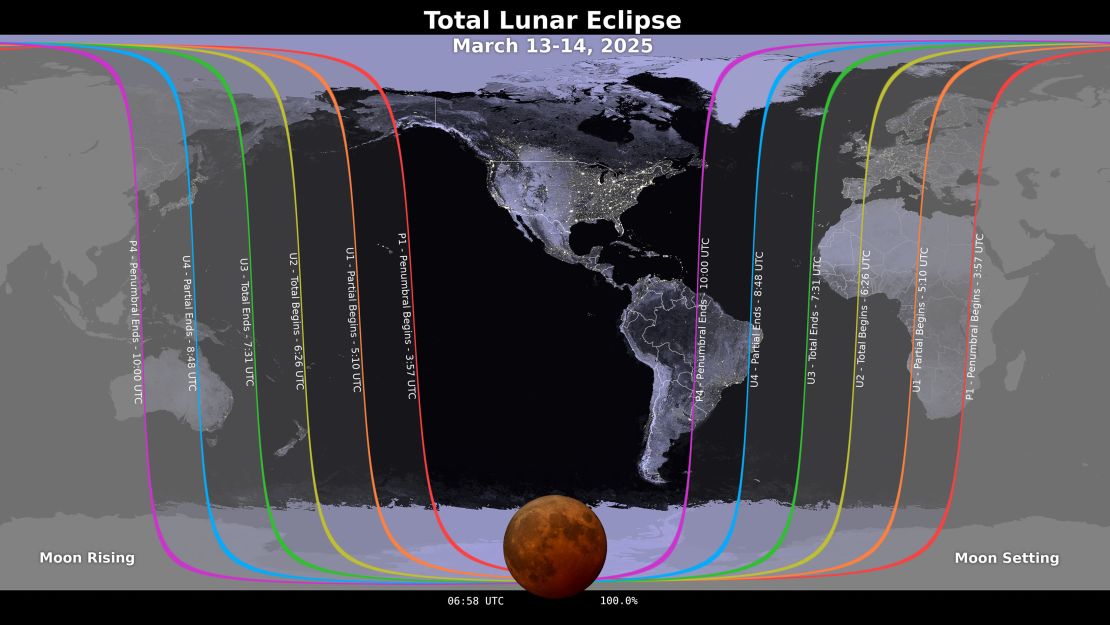Department of Research, Studies and International News 14-03-2025
A breathtaking celestial event is set to grace the night sky as the Earth moves directly between the sun and the moon, causing our natural satellite to glow in an eerie, reddish hue. The total lunar eclipse of March 13-14, 2025, will be visible across the Western Hemisphere, offering skywatchers a mesmerizing sight. Here’s everything you need to know about this rare phenomenon, from its cause and timing to the best ways to observe it.
Understanding a Total Lunar Eclipse
A lunar eclipse occurs when the Earth blocks sunlight from reaching the moon. This alignment results in the moon being cast into the Earth’s shadow, leading to different types of eclipses:
- Total Lunar Eclipse: the moon is fully enveloped in the Earth’s shadow, turning a deep red or orange due to the filtering of sunlight through Earth’s atmosphere.
- Partial Lunar Eclipse: Only a portion of the moon enters the Earth’s shadow, creating a contrast between its bright and darkened sections.
- Penumbral Lunar Eclipse: A subtle effect where the moon moves through the Earth’s outer shadow (the penumbra), causing a slight dimming rather than a dramatic transformation.
Why Does the Moon Turn Red?
The striking red hue seen during a total lunar eclipse is the result of Rayleigh scattering, the same phenomenon responsible for the colors of a sunset. As sunlight passes through the Earth’s atmosphere, shorter wavelengths (blue and violet) scatter in different directions, while longer wavelengths (red and orange) continue their journey and bend around the Earth. The remaining red-tinted light is what ultimately illuminates the moon, giving it a coppery glow.
When to See the Blood Moon Eclipse?
This total lunar eclipse will be fully visible in much of the Western Hemisphere, particularly in North and South America. Below are the key phases of the eclipse in Greenwich Mean Time (GMT) and Eastern Time (ET):
- Penumbral Eclipse Begins: 03:57 GMT (23:57 ET)
- Partial Eclipse Begins: 05:09 GMT (01:09 ET)
- Total Eclipse Begins: 06:26 GMT (02:26 ET)
- Maximum Eclipse (Deepest Red Shade): 06:58 GMT (02:58 ET)
- Total Eclipse Ends: 07:31 GMT (03:31 ET)
- Partial Eclipse Ends: 08:47 GMT (04:47 ET)
- Penumbral Eclipse Ends: 09:59 GMT (05:59 ET)
The total eclipse will last around 65 minutes, while the entire event will stretch over six hours.
How Rare is a Blood Moon?
While total lunar eclipses are not everyday occurrences, they are not extremely rare either. Typically, a few take place each decade. The last one was on November 8, 2022, and the next will occur on September 7-8, 2025, which will be visible from Asia, Africa, Australia, and parts of Europe.
The Significance of a Lunar Eclipse
Lunar eclipses have fascinated civilizations for centuries, holding importance across scientific, astronomical, and cultural domains.
Scientific Importance:
Studying Earth’s Atmosphere: By analyzing how sunlight filters through the Earth’s atmosphere before reaching the moon, scientists can assess atmospheric conditions, including pollution levels and volcanic activity.
Understanding Exoplanets: NASA utilizes lunar eclipses as a model for studying distant planets, observing how light behaves when passing through their atmospheres.
Exploring the Earth-Moon-Sun Relationship: These events help researchers refine their understanding of celestial mechanics and gravitational influences.
Cultural and Mythological Interpretations:
Throughout history, lunar eclipses have been surrounded by myths and superstitions. Many cultures viewed them as omens or divine messages:
- In Hindu mythology, the demon Rahu is said to swallow the moon, temporarily darkening the sky.
- Mayan tradition attributes the phenomenon to a jaguar devouring the moon.
- Ancient Chinese folklore tells of a heavenly dog consuming the moon, leading people to bang drums and make noise to scare it away.
Even today, some people consider blood moons to be symbolic of change and transformation.
How to Watch the Lunar Eclipse
Unlike solar eclipses, lunar eclipses are completely safe to view with the naked eye. To experience this cosmic event at its best, follow these tips:
- Find a Dark Location: Observing the eclipse away from city lights will enhance visibility.
- Use Binoculars or a Telescope: While not necessary, these tools can help you see the moon’s surface details more clearly.
- Monitor Weather Conditions: Clear skies will provide the best view, so check local forecasts in advance.
- Join a Livestream: If cloud cover obstructs your view, space agencies and observatories often provide online broadcasts of the event.
The total lunar eclipse of March 13-14, 2025, will be a stunning event for stargazers and casual observers alike. With its fiery red glow, the blood moon serves as both a scientific marvel and a celestial spectacle steeped in cultural lore. Mark your calendars and prepare to witness one of nature’s most captivating performances.

